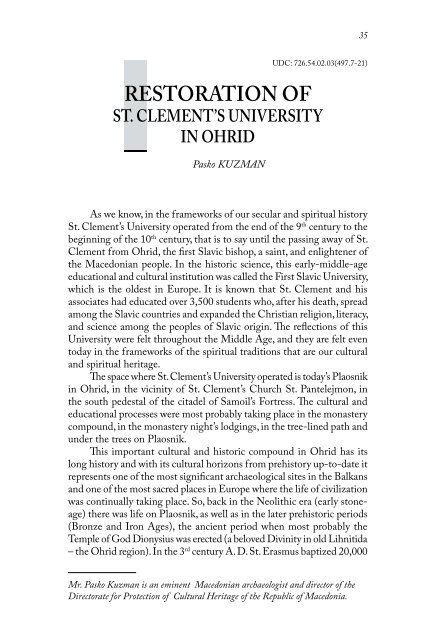CULTURAL HERITAGE: - Macedonian Information Centre
CULTURAL HERITAGE: - Macedonian Information Centre
CULTURAL HERITAGE: - Macedonian Information Centre
You also want an ePaper? Increase the reach of your titles
YUMPU automatically turns print PDFs into web optimized ePapers that Google loves.
RESTORATION OF<br />
ST. CLEMENT’S UNIVERSITY<br />
IN OHRID<br />
Pasko kuzMan<br />
As we know, in the frameworks of our secular and spiritual history<br />
St. Clement’s University operated from the end of the 9 th century to the<br />
beginning of the 10 th century, that is to say until the passing away of St.<br />
Clement from Ohrid, the first Slavic bishop, a saint, and enlightener of<br />
the <strong>Macedonian</strong> people. In the historic science, this early-middle-age<br />
educational and cultural institution was called the First Slavic University,<br />
which is the oldest in Europe. It is known that St. Clement and his<br />
associates had educated over 3,500 students who, after his death, spread<br />
among the Slavic countries and expanded the Christian religion, literacy,<br />
and science among the peoples of Slavic origin. The reflections of this<br />
University were felt throughout the Middle Age, and they are felt even<br />
today in the frameworks of the spiritual traditions that are our cultural<br />
and spiritual heritage.<br />
The space where St. Clement’s University operated is today’s Plaosnik<br />
in Ohrid, in the vicinity of St. Clement’s Church St. Pantelejmon, in<br />
the south pedestal of the citadel of Samoil’s Fortress. The cultural and<br />
educational processes were most probably taking place in the monastery<br />
compound, in the monastery night’s lodgings, in the tree-lined path and<br />
under the trees on Plaosnik.<br />
This important cultural and historic compound in Ohrid has its<br />
long history and with its cultural horizons from prehistory up-to-date it<br />
represents one of the most significant archaeological sites in the Balkans<br />
and one of the most sacred places in Europe where the life of civilization<br />
was continually taking place. So, back in the Neolithic era (early stoneage)<br />
there was life on Plaosnik, as well as in the later prehistoric periods<br />
(Bronze and Iron Ages), the ancient period when most probably the<br />
Temple of God Dionysius was erected (a beloved Divinity in old Lihnitida<br />
– the Ohrid region). In the 3 rd century A. D. St. Erasmus baptized 20,000<br />
Mr. Pasko kuzman is an eminent <strong>Macedonian</strong> archaeologist and director of the<br />
directorate for Protection of Cultural Heritage of the republic of Macedonia.<br />
35<br />
UDC: 726.54.02.03(497.7-21)


